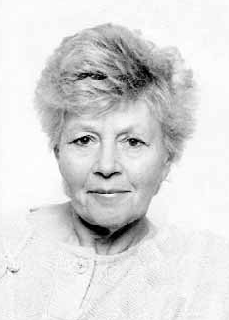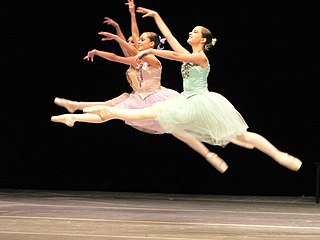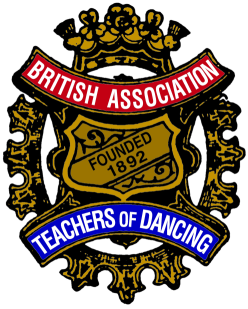The Cecchetti method is variously defined as a style of ballet and as a ballet training method devised by the Italian ballet master Enrico Cecchetti (1850–1928). The training method seeks to develop essential skills in dancers as well as strength and elasticity. Cecchetti-trained dancers are commonly found in ballet and other dance companies throughout the world.

Doreen Bird MA FISTD ARAD was a British dance teacher and founder of the Doreen Bird College of Performing Arts in Sidcup, Kent. She was a fellow, examiner, lecturer, committee and council member of the ISTD, life member of the RAD, and Honorary MA. Prior to her death from Leukaemia in 2004, she had been studying towards a Ph.D. As well as being a respected dance figure in the United Kingdom, Bird also travelled the World as a lecturer and adjudicator specialising in dance and musical theatre. The college which Bird founded is now recognised Internationally as a centre of excellence for dance and performing arts, with its students working worldwide in high-profile areas of the performing industry including West End and Broadway theatre.

The International Dance Teachers Association (IDTA) is a dance teaching and examination board based in Brighton, England. Operating internationally, the IDTA currently has over 7,000 members in 55 countries. The IDTA is recognised by the national qualifications regulators in England and Wales, Ofqual and the Council for Dance Education and Training, and is also affiliated to the British Dance Council, the Central Council of Physical Recreation and the Theatre Dance Council International. The IDTA works in partnership with the Royal Academy of Dance. The IDTA publishes a print and online magazine for members titled Dance International four times a year.

The Royal Academy of Dance (RAD) is a UK-based examination board specialising in dance education and training, with an emphasis on classical ballet. The RAD was founded in London, England in 1920 as the Association of Teachers of Operatic Dancing, and was granted a Royal Charter in 1935. Queen Elizabeth II was patron of the RAD and Darcey Bussell was elected to serve as president in 2012, succeeding Antoinette Sibley who served for 21 years.

Concert dance is dance performed for an audience. It is frequently performed in a theatre setting, though this is not a requirement, and it is usually choreographed and performed to set music.
In many forms of dance medal examinations are held. They are organised by leading dance teaching organisations, such as the Imperial Society of Teachers of Dancing (ISTD), the International Dance Teachers Association (IDTA), and other organisations.
bbodance, formerly the British Ballet Organization (BBO), is a dance examination board based in London, England.

The British Association of Teachers of Dance (BATD) is a UK-based dance examination board, with its Head Office in Glasgow, Scotland. The officially recognised date for the formation of the society is 30 November 1892, making it the first professional dance organization of its kind in the United Kingdom, and the second oldest in the world.
Gwenethe Walshe was a leading British Latin and ballroom dancer. Born in Wanganui, New Zealand, she lived most of her life in England and moved to Australia after her retirement. She arrived in England in 1936, and by 1938 she had founded a dance school bearing her name in London's West End, which is still operating as the Central London Dance. During World War II she worked by day as a WVS nurse and by night continued to run classes, even during air raids. Gwenethe simply turned up the music and the dancing continued!

The British Dance Council was formed in 1929 as the Official Board of Ballroom Dancing (OBBD). The name was changed in 1985 to the British Council of Ballroom Dancing and in 1996, the name was changed to British Dance Council. The BDC is the recognised governing body for Ballroom, Latin American, Sequence & Freestyle Disco dance in the United Kingdom.

Stella Mann College of Performing Arts is an independent, co-educational performing arts school and college specialising in dance and musical theatre. The college is located in the Harpur area of Bedford, Bedfordshire, England.
British ballet is most recognised for two leading methods, those of the Royal Ballet School and the Royal Academy of Dance. The identifying characteristic of British ballet is the focus on clean, precise technique and purity of line that is free of exaggeration and mannerisms. The training of dancers in Britain is noted for its slow progression, with a great deal of attention paid to basic technique. British ballet methods operate on the principle that establishing correct technique and strength slowly makes it much easier for the student to adapt to more difficult vocabulary and techniques later on.
Monsieur Pierre was the professional name of Pierre Jean Philippe Zurcher-Margolle. He was a professional dancer and dance teacher, largely responsible for introducing the Latin American dances to England, and for codifying them, and laying the groundwork for their use in competitions and in social dance. The system he and his colleagues developed became the basis for all Latin and American competitions held under the World Dance Council (WDC).
Dimitri Petrides was a ballroom dancer who was instrumental in pioneering and developing Latin American dancing in England and later globally. He left Cyprus when he was eighteen with his mother after the death of his father, eventually settling in England. He was one of the founding members of the Latin-American Faculty of the Imperial Society of Teachers of Dancing, and wrote the first English textbook on the subject. He was a Fellow and Examiner of the ISTD.
The Council for Dance, Drama and Musical Theatre (CDMT), formerly known as the Council for Dance Education and Training (CDET), is the quality assurance and membership body for the professional dance, drama and musical theatre industries in the United Kingdom. CDMT was founded in 1979.
The National Association of Teachers of Dancing promotes dance and provides services to its members.
Jillian La Valette is a professional ballroom dancer and teacher. With her dance partner James Arnell she won the professional International Latin American Dance Championship six times between 1955 and 1965.

UKA Dance, formally known as the United Kingdom Alliance (UKA), is a dance teaching and examination board based in Blackpool, England, and operates internationally. UKA Dance was established in 1902 and provides training in a range of dance styles, with examination syllabi for students, and training courses for people wishing to become certified dance teachers.
The National Dance Council of America (NDCA) is an organisation formed in 1948 which set standards for ballroom dance teachers, and competitions similar to the Imperial Society of Teachers of Dancing (ISTD) founded 1904 in London.








